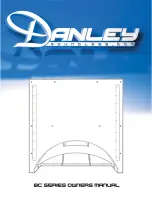
SYSTEM PLANNING
The largest possible impact on any audio
system (home or car) is the quality of
loudspeakers used and their placement.
EFFICIENCY defines how loud a speaker will
play for a given input power and is often
quoted at 1 watt input and measured at a 1
meter distance. When designing a system
you want to keep the component efficiencies
as close as possible (This is usually
addressed
a safe bet to buy from one company.).
Always match components for efficiency and
complementing frequency response to
.
ensure smooth transition from low
FREQUENCY
frequencies to higher ones for accurate performance. Remember that for every 3
of
increased efficiency (SPL) a speaker has over another, the end performance is as if the
amplifier has doubled it’s power output.
KER CONFIGURATIONS can become a problem in autosound installations. We would
achieve a sound field in front of us (like a live concert) as compared to sound partly from
the front and partly behind us. This virtually dictates good midrange and tweeter speakers in
front, usually mounted in the doors for good left/right balance, with high-pass crossovers set
greater than 80-100 Hz. For deep bass a subwoofer is required but is nearly always located
behind us in a rear trunk or hatch area. If the subwoofer crossover is too hi h in frequency
male voices can be heard “gurgling” out of the subwoofer speaker and there ore
sound-stage to the rear of the car, which is undesirable.
pulls the
AMPLIFIER POWER is important but should be of lesser importance compared to speaker
choice and placement. Matching the rms (continuous) power levels to that of the speaker is
important but it should be -noted that under-powering a system can often cause more damage
than slightly overpowering it. If the speakers are rated for 50 watts rms, you can often drive
them with a 100 watt power amp without concern. IMPEDANCE is the electrical resistance to
AC current flow and is typically 4 ohms for most car speakers. Impedance loads for a speaker
configuration shouldn’t fall below 2-4 ohms for most installations to avoid amplifier overheating,
regardless of manufacturer (Impedance = D.C. resistance of the voice coil wire + A.C.
resistance due to the coil of wire formed).
forward creating a positive pressure wave, this same motion
a negative pressure at the
back of the woofer. If these two waves combine due to the lack of a wall separating the front of
the speaker sound from the back, the output from the woofer is effectively canceled thus
substantially reducing the bass output of the speaker. This wall is absolutelv necessary and is
referred to as an acoustical “baffle”. It can be accomplished using a box of some kind or simply
the rear package shelf of a car to isolate the front and back waves of the speaker.
THIELE-SMALL PARAMETERS
Ev
woofer has its own electromechanical characteristics which are called
F
eters.
_
The three most important parameters include RESONANT FREQUENCY
where the speaker moves with the least mechanical resistance), TOTAL
the “magnification” of the cone movement at its resonant frequency), and VOLUMETRIC
COMPLIANCE
the equivalent volume of air that the woofer cone can displace for a
given power input). Using these parameters we can then calculate an optimum box volume for
a particular woofer and predict its associated frequency response.






































